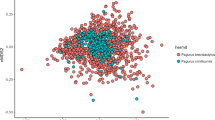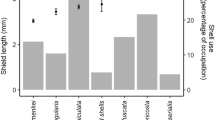Abstract
Hermit crabs recognize different shell attributes and choose shell size, type, or species to maximize their individual fitness. Aquatic hermit crab species commonly prefer relatively heavy shells species in contrast to semi-terrestrial crabs which prefer lighter shells. Lighter shells favor rapid growth and increase individual fitness because larger individual achieve higher success in intra- and inter-individual competition. In this study, we experimentally measured the daily growth of hermit crabs Calcinus californiensis that were forced to occupy four different shell species with different internal volume to mass ratios (IV/M ratio), and whose sequence in preference is known from previous studies (Cantharus > Stramonita > Columbella > Nerita). The shell with the highest IV/M ratio (Nerita) favored body growth rate, while the relatively heaviest (lowest IV/M ratios) and most preferred shells (Stramonita and Cantharus) hindered body growth. Our results suggest that in this aquatic hermit crab, the benefits of carrying heavy shells that give better predatory protection exceeded the benefits of rapid growth that can be obtained using lighter, thinner, and less protective shells.

Similar content being viewed by others
References
Alcaraz, G. & K. Kruesi, 2012. Exploring the phenotypic plasticity of standard metabolic rate and its inter-individual consistency in the hermit crab Calcinus californiensis. Journal of Experimental Marine Biology and Ecology 412: 20–26.
Angel, J. E., 2000. Effects of shell fit on the biology of the hermit crab Pagurus longicarpus (Say). Journal of Experimental Biology 243: 169–184.
Arce, E. & G. Alcaraz, 2012. Shell preference in a hermit crab: comparison between paired shell choice trials and a multiple alternatives experiment. Marine Biology 159: 853–862.
Arce, E. & G. Alcaraz, 2013. Plasticity of shell preference and its antipredatory advantages in hermit crabs. Canadian Journal of Zoology 91: 321–327.
Arendt, F. D., 1997. Adaptive intrinsic growth rates: an integration across taxa. Quarterly Review of Biology 72: 149–177.
Bertness, M. D., 1981a. The influence of shell-type on hermit crab growth rate and clutch size (Decapoda, Anomura). Crustaceana 40: 197–205.
Bertness, M. D., 1981b. Conflicting advantages in resource utilization: the hermit crab housing dilemma. American Naturalist 118: 432–437.
Bertness, M. D. & C. Cunningham, 1981. Crab shell-crushing predation and gastropod architectural defense. Journal of Experimental Marine Biology and Ecology 50: 213–230.
Biro, P. A., M. V. Abrahams, J. R. Post & E. A. Parkinson, 2006. Behavioural trade-offs between growth and mortality explain evolution of submaximal growth rates explain evolution of submaximal growth rates. Journal of Animal Ecology 75: 1165–1171.
Blackstone, N. W., 1985. The effects of shell size and shape on growth and form in the hermit crab Pagurus longicarpus. Biological Bulletin 168: 75–90.
Childress, J. R., 1972. Behavioral ecology and fitness theory in a tropical hermit crab. Ecology 53: 960–964.
Contreras-Garduño, J., J. L. Osorno & C. Macías-García, 2009. Weight difference threshold during shell selection relates to growth rate in the semi-terrestrial hermit crab Coenobita compressus. Behaviour 146: 1601–1614.
Denny, M. W., 1993. Air and Water. The Biology and Physics of Life’s Media. Princeton University Press\, Princeton.
Fotheringham, N., 1976a. Effects of shell stress on the growth of hermit crabs. Journal of Experimental Marine Biology and Ecology 23: 299–305.
Fotheringham, N., 1976b. Population consequences of shell utilization by hermit crabs. Ecology 57: 570–578.
Gillis, G. B. & R. W. Blob, 2001. How muscles accommodate movement in different physical environments: aquatic vs. terrestrial locomotion in vertebrates. Comparative Biochemistry and Physiology A 131: 61–75.
Hazlett, B. A., 1981. The behavioral ecology of hermit crabs. Annual Review of Ecology and Systematics 12: 1–22.
Hazlett, B. A. & L. C. Baron, 1989. Influence of shell on mating behavior in the hermit crab Calcinus tibicen. Behavioral Ecology and Sociobiology 24: 269–376.
Herreid, C. F. & R. J. Full, 1986. Energetics of hermit crabs during locomotion: the cost of carrying a shell. Journal of Experimental Biology 120: 297–308.
Laidre, M. E., E. Patten & L. Pruitt, 2012. Costs of a more spacious home after remodelling by hermit crabs. Journal of the Royal Society Interface 9: 3574–3577.
Mantelatto, F. L. & R. B. García, 2000. Shell utilization pattern of the hermit crab Calcinus tibicen (Diogenidae) from southern Brazil. Journal of Crustacean Biology 20: 460–467.
Martinez, M. M., R. J. Full & M. A. R. Koehl, 1998. Underwater punting by an intertidal crab: a novel gait revealed by the kinematics of pedestrian locomotion in air versus water. Journal of Experimental Biology 201: 2609–2623.
Mima, A., S. Wada & S. Goshima, 2003. Antipredator defence of the hermit crab Pagurus filholi induced by predatory crabs. Oikos 102: 104–110.
Munch, S. B. & D. O. Conover, 2003. Rapid growth results in increased susceptibility to predation in Menidia menidia. Evolution 57: 2119–2127.
Osorno, J. L., F. Fernández-Casillas & C. Rodríguez-Juárez, 1998. Are hermit crabs looking for light and large shells? Evidence from natural and field induced shell-exchanges. Journal of Experimental Marine Biology and Ecology 222: 163–173.
Osorno, J. L., J. Contreras-Garduño & C. Macías-García, 2005. Long-term costs of using heavy shells in terrestrial hermit crabs (Coenobita compressus) and the limits of shell preferences: an experimental study. Journal of Zoology 266: 377–383.
Pace, C. M. & A. C. Gibb, 2009. Mudskipper pectoral fin kinematics in aquatic and terrestrial environments. Journal of Experimental Biology 212: 2279–2286.
Rotjan, R. & J. Blum, 2004. Shell choice in Pagurus longicarpus hermit crabs: does predation threat influence shell selection behavior? Behavioral Ecology and Sociobiology 56: 171–176.
Sibly, R. M. & P. Calow, 1987. Growth and resource allocation. In Calow, P. (ed.), Evolutionary Physiological Ecology. Cambridge University Press, Cambridge.
Stearns, S., 1992. The Evolution of Life Histories. Oxford University Press, New York.
Stoks, R., M. De Block, F. Van De Meutter & F. Johansson, 2005. Predation cost of rapid growth: behavioural coupling and physiological decoupling. Journal of Animal Ecology 74: 708–715.
Taylor, P. R., 1981. Hermit crab fitness: the effect of shell condition and behavioral adaptations on environmental resistance. Journal of Experimental Marine Biology and Ecology 52: 205–221.
von Ende, C. N., 1993. Repeated measures analysis: growth and other time dependent measures. In Scheiner, S. M. & J. Gurevich (eds), Design and analysis of ecological experiments. Chapman & Hall, New York: 113–137.
Wada, S., H. Ohmori, S. Goshima & S. Nakao, 1997. Shell-size preference of hermit crabs depends on their growth rate. Animal Behavior 54: 1–8.
Werner, E. E. & B. R. Anholt, 1993. Ecological consequences of the trade-off between growth and mortality rates mediated by foraging activity. American Naturalist 142: 242–272.
Zar, J. H., 2010. Biostatistical Analysis, 5th ed. Pearson Prentice-Hall, Upper Saddle River.
Acknowledgments
This study was supported by Programa de Apoyo a Proyectos de Investigación e Innovación Tecnológica (UNAM-DGAPA-PAPIIT, IN-213112) and Consejo Nacional de Ciencia y Tecnología (CONACyT, CB-2011-167915). We thank Patricia Cortes and Gastón Jofre for editing this English-language text.
Author information
Authors and Affiliations
Corresponding author
Additional information
Handling editor: Diego Fontaneto
Rights and permissions
About this article
Cite this article
Alcaraz, G., Chávez-Solís, C.E. & Kruesi, K. Mismatch between body growth and shell preference in hermit crabs is explained by protection from predators. Hydrobiologia 743, 151–156 (2015). https://doi.org/10.1007/s10750-014-2029-8
Received:
Revised:
Accepted:
Published:
Issue Date:
DOI: https://doi.org/10.1007/s10750-014-2029-8




